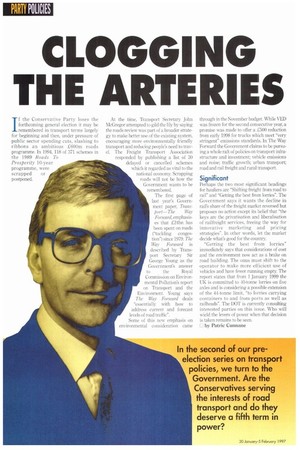CLOGG NG THE ART
Page 38

If you've noticed an error in this article please click here to report it so we can fix it.
/f the Conservative Party loses the forthcoming general election it may be remembered in transport terms largely for beginning and then, under pressure of public sector spending cuts, slashing to ribbons an ambitious £600m roads programme. In 1994, 118 of 371 schemes in the 1989 Roads To Prosperity 10-year programme, were scrapped or postponed.
At the time, Transport Secretary John McGregor attempted to gild the lily by saying the roads review was part of a broader strategy to make better use of the existing system, encouraging more environmentally friendly transport and reducing people's need to travel. The Freight Transport Association responded by publishing a list of 30 delayed or cancelled schemes which it regarded as vital to the national economy. Scrapping roads will not be how the Government wants to be remembered.
The first page of last year's Government paper, Trans port—The Way Forward, emphasis
es that .C24bn has
been spent on roads ("tackling congestion") since 1979. The Way Forward is described by Trans
port Secretary Sir George Young as the Government's answer to the Royal Commission on Environmental Pollution's report on Transport and the
Environment. Young says The Way Forward deals "essentially with how to
address current and forecast levels of road traffic".
Sonic of this new emphasis on environmental consideration came through in the November budget. While VED was frozen for the second consecutive year, a promise was made to offer a £500 reduction from early 1998 for trucks which meet "very stringent" emissions standards, In The Way Forward the Government claims to be pursuing a whole raft of policies on transport infrastructure and investment; vehicle emissions and noise; traffic growth; urban transport road and rail freight and rural transport.
Significant
Perhaps the two most significant headings for hauliers are "Shifting freight from road to rail" and "Getting the best from lorries". The Government says it wants the decline in rail's share of the freight market reversed but proposes no action except its belief that "the keys are the privatisation and liberalisation of railfreight services, freeing the way for innovative marketing and pricing strategies". In other words, let the market decide what's good for the country "Getting the best from lorries" immediately says that considerations of cost and the environment now act as a brake on road building. The onus must shift to the operator to make more efficient use of vehicles and have fewer running empty The report states that from 1 January 1999 the UK is committed to 40-tonne lorries on five axles and is considering a possible extension of the 44-tonne limit, "to lorries carrying containers to and from ports as well as railheads". The DOT is currently consulting interested parties on this issue. Who will wield the levers of power when that decision is taken remains to be seen.
Li by Patric Cunnane








































































































